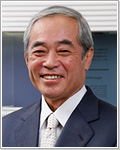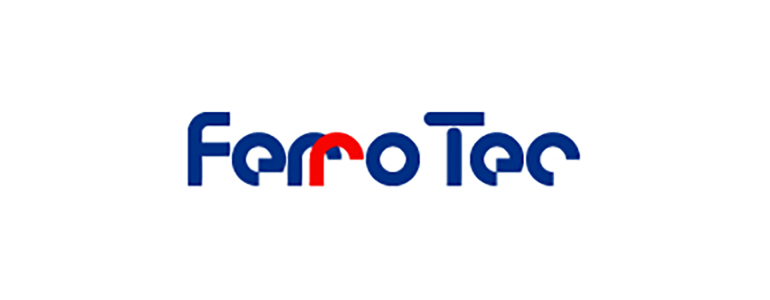| Ferrotec Corporation (6890) |
|
||||||||
Company |
Ferrotec Corporation |
||
Code No. |
6890 |
||
Exchange |
JASDAQ |
||
Industry |
Electric Equipment (Manufacturing) |
||
President |
Akira Yamamura |
||
HQ Address |
Nihonbashi Plaza Building, Nihonbashi 2-3-4, Chuo-ku, Tokyo |
||
Year-end |
March |
||
URL |
|||
* Stock price as of closing on December 2, 2011. Number of shares at the end of the most recent quarter excluding treasury shares.
ROE and BPS are calculated by using actual amounts during or at the end of the previous term.
|
||||||||||||||||||||||||
|
|
* Estimates are those of the Company.
|
|
| Key Points |
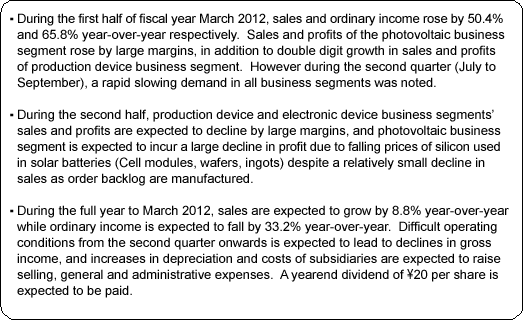 |
| Company Overview |
|
<Business Segments>
Ferrotec' s operations can be divided between the production device, electronic device, and photovoltaic business segments, which accounted for 48%, 12% and 37% of fiscal year March 2011 sales respectively (Others includes saw blades, equipment part cleansing, machine tool, and other products not included in reported segments accounting for 3% of sales). In recent years, manufacturing equipment, quartz crucibles, and other products in the photovoltaic device business segment have experienced rapid growth. Ferrotec is able to leverage the knowhow and technologies it has cultivated in the realm of vacuum seals, which are a major component in manufacturing equipment that produces silicon for solar cells.
< "Challenge 1000" Midterm Business Plan>
Ferrotec celebrates its 31st year of operations in fiscal year March 2012 and has identified the period going forward as its "Second Founding." Also this year marks the start of the "Challenge 1000" Midterm Business Plan (From fiscal year March 2012 to 2014) which targets the photovoltaic device and LED related businesses to become growth drivers.
Concrete Measures of the "Challenge 1000"
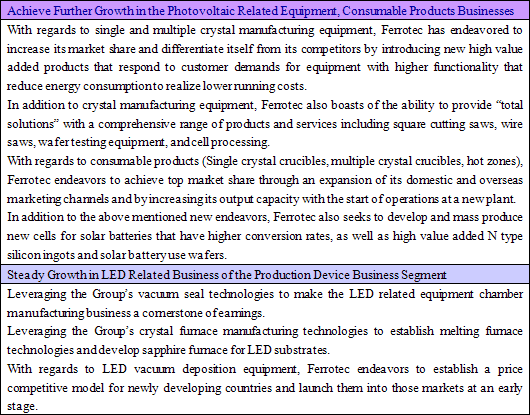 |
| First Half Fiscal Year March 2012 Earnings Results |
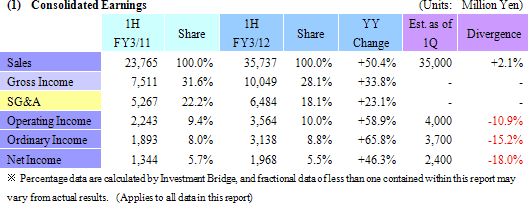 Sales and Ordinary Income Rise by 50.4% and 65.8% Year-Over-Year
Sales of silicon crystal manufacturing equipment, crucibles, silicon used for solar cells, and other products in the photovoltaic business segment grew by a large margin, along with strong sales of the production device and electronic device business segments. Consequently, sales rose by 50.4% year-over-year to ¥35.73 billion. With regards to profits, declines in pricing of silicon used in solar cells and higher inventory valuation losses (¥300 million) led to declines in gross margins. However higher sales helped to absorb increases in variable costs associated with the start of a new plant and SG&A (selling, general and administrative) expenses arising from the establishment of subsidiaries, thus allowing operating income to rise by 58.9% year-over-year to ¥3.56 billion. Increases in interest and commission payments due to the establishment of a syndicated loan led to an increase in non-operating expense. Furthermore losses on liquidation of fixed assets of ¥70 million and lump sum amortization of appointment contract of ¥170 million led to an extraordinary loss of ¥400 million. Consequently net income grew by a lower margin of 46.3% year-over-year to ¥1.96 billion. Capital investments of ¥4.29 billion (¥2.09 billion in the previous term) and depreciation of ¥1.37 billion (¥1.30 billion in the previous term) were recorded. Foreign exchange rates of ¥81.78 per US Dollar (¥91.02 in the previous term), and ¥12.52 per Chinese Yuan (¥13.34 in the previous term) were observed. While the favorable results during the first half are due in large part to the strong performance during the first quarter (April to June), a rapid slowing seen in all segments was noted during the second quarter (July to September). During the second quarter, sales managed to grow, but profits declined due in part to inventory valuation losses (¥300 million) and delays in shipments of some silicon crystal manufacturing equipment (Impact: Reduced sales and operating income by ¥1.35 billion and ¥420 million respectively).
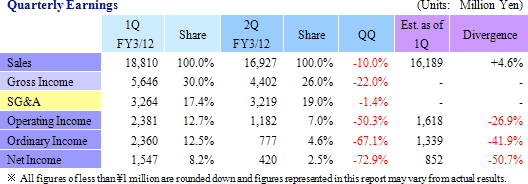 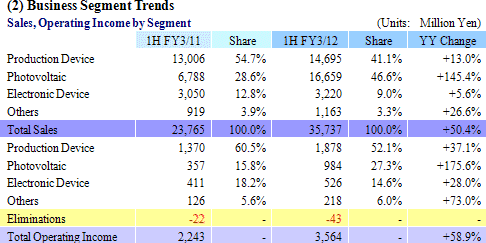 Production Device Business Segment
Sales and operating income rose by 13.0% and 37.1% year-over-year to ¥14.69 billion and ¥1.87 billion respectively. However a slowing in demand was noted after the start of the second quarter.
Conditions by Product
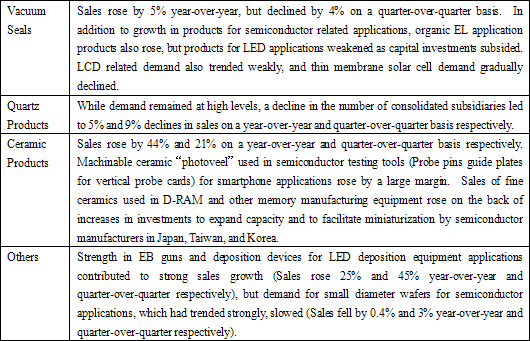 Photovoltaic Business Segment
Sales and operating income rose by 145.4% and 175.6% year-over-year to ¥16.65 billion and ¥980 million respectively. Despite the strong sales and profit growth during the first half, an increase in inventories in the cell module market led to sudden declines in prices of cells modules, wafers, and ingots during the second quarter, which in turn led to valuation losses on inventories. Furthermore delays in shipments of some silicon crystal manufacturing equipment also negatively impacted earnings.
Conditions by Product
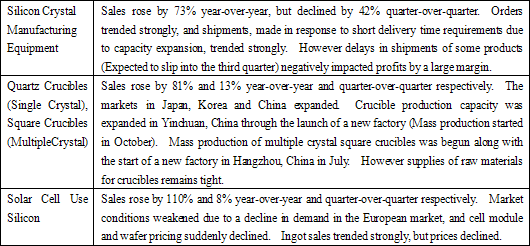 Electronic Device Business Segment
Sales and operating income rose by 5.6% and 28.0% year-over-year to ¥3.22 billion and ¥520 million respectively. Demand for the main product of thermoelectric modules for automated seat heaters on the back of strong automobile sales in newly developing country markets trended strongly. In addition, products for air conditioners and other consumer product applications grew, along with favorable demand for high functionality products for biotechnology and fiber optic communication applications.
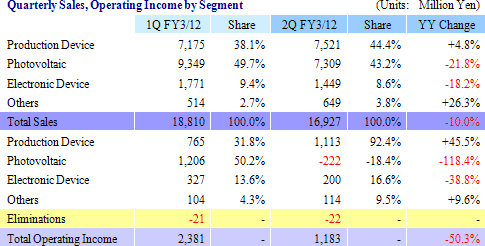 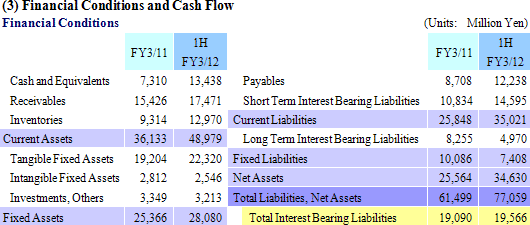  |
| Fiscal Year March 2012 Earnings Estimates |
 Estimates Call for Sales to Rise by 8.8%, Ordinary Income to Fall by 33.2%
During the second half of the current term, production device business and electronic device business segments are expected to see large declines in both sales and profits. In addition, the processing of orders backlog is expected to contribute to a relatively small decline in sales of the photovoltaic business segment, but profits are expected to decline by a large margin due to declines in solar cell use silicon (Cell modules, wafers, ingots) pricing.In the full year, lower sales of production device and electronic device business segments are expected to lead to declines in marginal profitability of these businesses. At the same time, profitability of the photovoltaic business segment is expected to deteriorate due to declines in pricing despite higher sales. In addition, higher selling, general and administrative expenses, arising from increases in subsidiaries, and depreciation, resulting from aggressive capital investments, are expected to contribute to a 25.0% year-over-year decline in operating income to ¥5.2 billion. During the full year, capital investments and depreciation are expected to amount to ¥7.0 billion (¥5.03 billion in the previous term) and ¥3.35 billion (¥2.65 billion in the previous term) respectively. Ferrotec assumes foreign exchange rates of ¥75 per US Dollar (¥83.8 in the previous term) and ¥12 per Chinese Yuan (¥12.5 in the previous term). Ferrotec also projects a yearend dividend of ¥20 per share. Moreover, sales estimates have been revised down from initial estimates due to near term weakness in the solar cell and semiconductor markets. And while reductions in costs of goods sold and selling, general and administrative expenses are expected to be pursued in part through internalization of subcontracted work, Ferrotec has reviewed its estimates for gross profitability due to declines in product pricing and subsequently revised its estimates for operating income downwards as well. In addition, a worsening in non-operating income is also anticipated on the back of foreign exchange translation losses resulting from the rapid strengthening of the Yen.  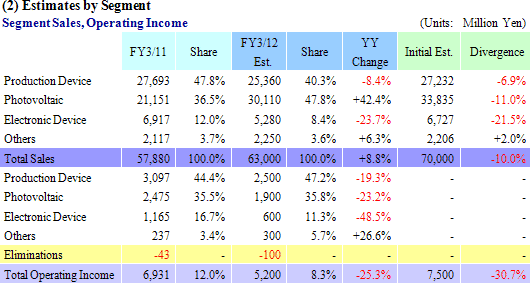 Production Device Business Segment
Sales and operating income are expected to fall by 8.4% and 19.3% year-over-year to ¥25.36 and ¥2.50 billion respectively. Declines in demand for various finished products are expected to contribute to weaker demand for investments in various production devices. At the same time demand for consumable products used in various production processes are also expected to weaken. Explanations of the near term conditions and outlook for various products and endeavors are provided in the table below.
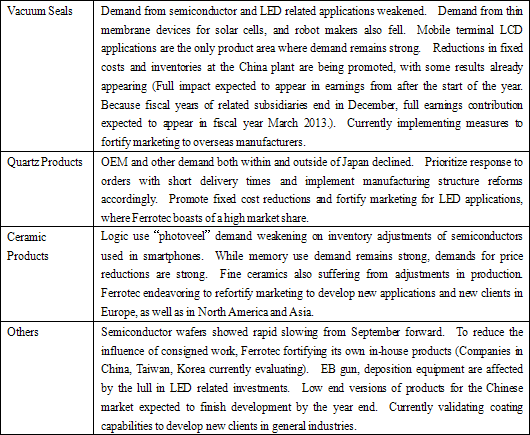 Photovoltaic Business Segment
Sales are expected to rise by 42.4% year-over-year to ¥30.11 billion while operating income are projected to fall by 23.2% year-over-year to ¥1.90 billion. Delays in solar panel inventory adjustments in the European market are contributing to continued pricing declines in solar cell and wafers, which in turn is expected to contribute to declines in demand for silicon crystal manufacturing equipment, consumable products, and materials. The weaker prices are also expected to impact earnings. Therefore, in addition to responding to client requests for short delivery times for silicon crystal manufacturing equipment, cost reductions, and productivity improvements (Pulling speed increases) through reforms of hot zones, which are the core component of equipment, are being implemented. In line with these trends, Ferrotec is introducing new products that respond to client needs and fortifying its marketing capabilities for other overseas markets besides China. Furthermore, the Company is promoting efforts to fortify its earnings model by reducing parts and materials costs, cutting expenses, reducing inventories, and rationalizing their work force. Explanations of the near term conditions and outlook for various products and endeavors are provided in the table below.
Market Conditions and Endeavors by Product
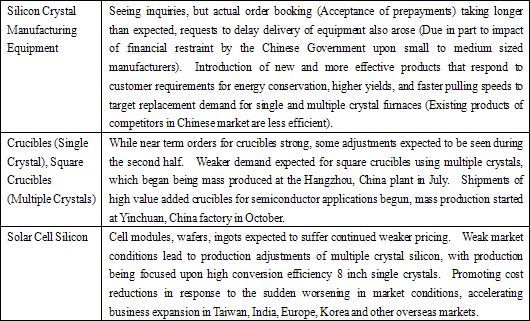 Electronic Device Business Segment
Sales and operating income are expected to fall by 23.7% and 48.5% year-over-year to ¥5.28 billion and ¥600 million respectively. While demand from applications in the medical, biotechnology equipment, semiconductor, optical technologies is expected to trend favorably, model changes of cars are expected to lead to a temporary inventory adjustment of thermoelectric modules for automated seat heaters (Sales to consumer product applications are expected to see a seasonal decline compared to the first half). In addition, demand in the market for optical communication applications continues to stagnate, but Ferrotec is fortifying its marketing function to expand its share of high end products.In addition to efforts to increase the Company' s pricing competitiveness through fortification of automated production lines, Ferrotec also endeavors to improve profitability with the development and introduction of products that use reduced amounts of rare metal (Tellurium) to offset their rising prices. At the same time the Company fortifies its marketing capability to expand sales of high end products for optical communication applications and by implementing measures to improve the quality of power device circuit boards. 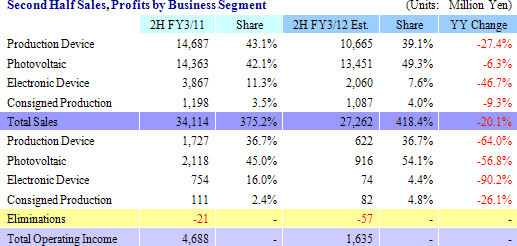 |
| Conclusions |
|
Given the severe near term operating conditions, it may be necessary for Ferrotec to prepare itself for a difficult operating environment to continue for about one year. However there is anticipation of improvements in orders for silicon crystal manufacturing equipment in the photovoltaic business segment from around March of next year. Furthermore there is speculation in the market that further relaxation of monetary policy with further reductions in the reserve deposit rates may also be implemented. All of Ferrotec's businesses exist in the realm of industries which may be considered to be growth industries, and its position as a global leader is yet another strength. Within the next several months, cost reductions of 10% and 40% are expected to be promoted in the production device and photovoltaic business segments respectively (Reductions of 1,500 staff expected to lead to monthly reduction in labor costs of ¥50 million per month from next term onwards). Furthermore, new silicon crystal manufacturing equipment that is 1.3 times faster, provides 20% better yields, and 20% more energy efficient than competing products are being developed to capture replacement demand. Therefore close attention must be paid to trends in semiconductor, FPD, and solar cell related production and capital investments, and the external operating environment, as well as to Ferrotec's measures to improve its profitability. Disclaimer
This report is intended solely for information purposes, and is not intended as a solicitation to invest in the shares of this company. The information and opinions contained within this report are based on data made publicly available by the Company, and comes from sources that we judge to be reliable. However we cannot guarantee the accuracy or completeness of the data. This report is not a guarantee of the accuracy, completeness or validity of said information and or opinions, nor do we bear any responsibility for the same. All rights pertaining to this report belong to Investment Bridge Co., Ltd., which may change the contents thereof at any time without prior notice. All investment decisions are the responsibility of the individual and should be made only after proper consideration.Copyright(C) 2011 Investment Bridge Co.,Ltd. All Rights Reserved. |

